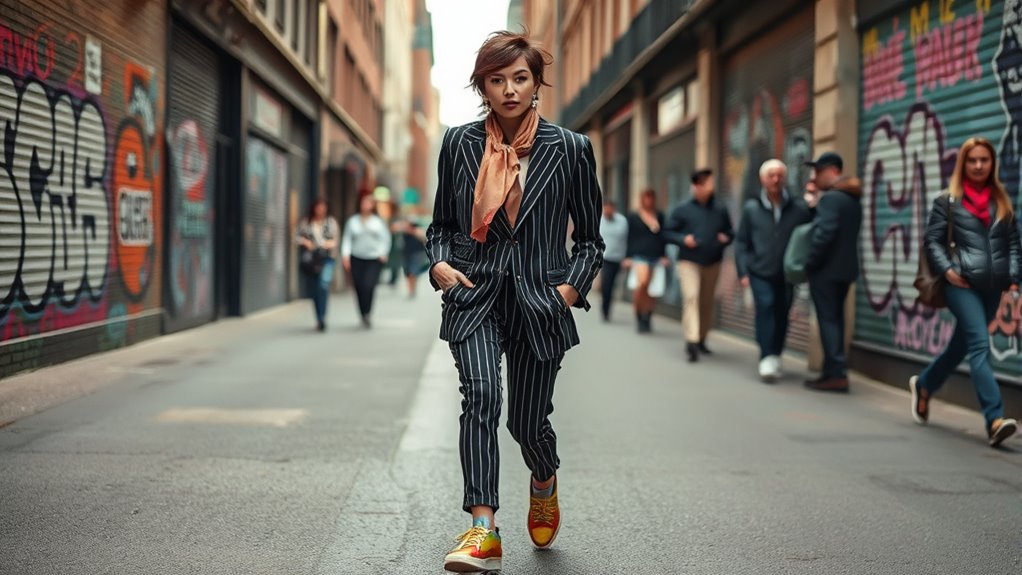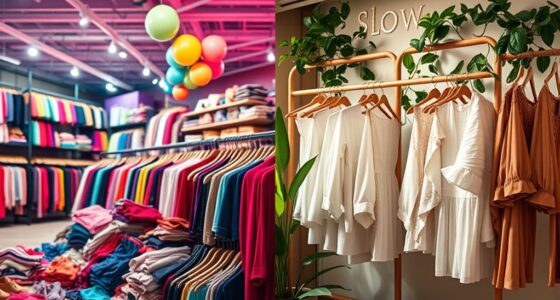Gender boundaries in fashion are evolving rapidly, with designers and influencers breaking traditional norms to promote inclusivity and personal expression. From gender-neutral collections and runway shows celebrating diversity, to social media empowering individual style choices, fashion now challenges stereotypes about what men and women can wear. As cultural and societal shifts continue, you’ll see more authentic styles that prioritize individuality over labels. Keep exploring, and you’ll discover how fashion is redefining itself for everyone.
Key Takeaways
- Fashion norms have shifted from rigid gender roles to inclusive, fluid styles promoting individual expression.
- Pioneers like Marlene Dietrich and David Bowie challenged traditional gender fashion boundaries.
- Gender-neutral collections and inclusive sizing foster diversity, body positivity, and social responsibility.
- Social media and technology democratize fashion, enabling personalized, boundary-breaking style expressions.
- Future trends emphasize sustainable, versatile, and culturally expressive designs that celebrate authenticity and diversity.
The Evolution of Gender Norms in Fashion
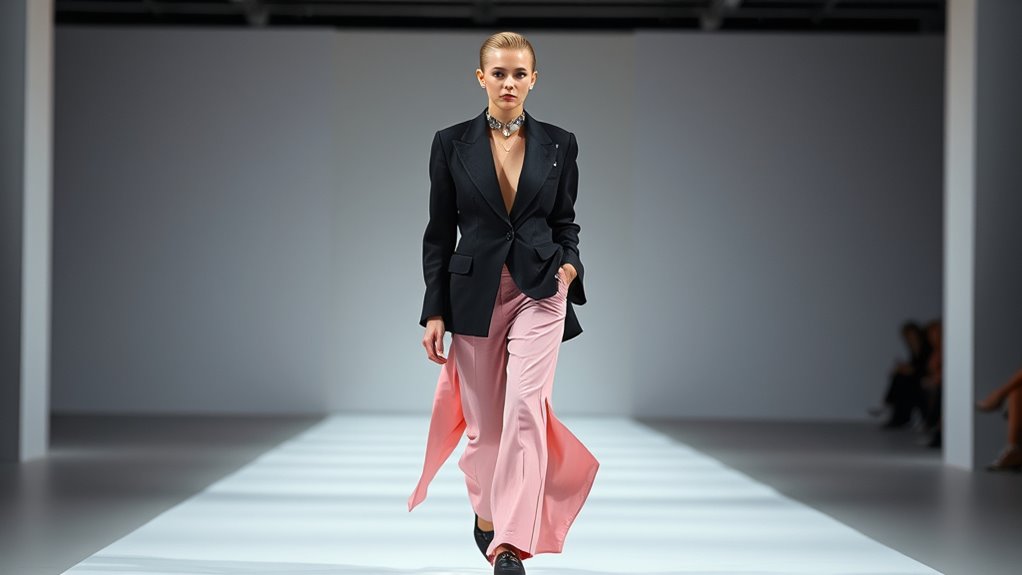
The way society views gender in fashion has shifted dramatically over time, reflecting broader changes in cultural attitudes. You’ve likely noticed how clothing once strictly assigned to men or women is now increasingly fluid. Historically, fashion reinforced gender roles—think of corsets for women or suits for men. Over the decades, these norms began to break down, especially during the 20th century, when societal upheavals challenged traditional ideas. The 1960s and 70s saw a surge in unisex styles, and today, many designers blur lines further with gender-neutral collections. You now have more freedom to express yourself without being confined by outdated expectations. This evolution highlights a growing acceptance of individual identity and a rejection of rigid gender stereotypes in fashion.
Influential Pioneers Challenging Traditional Styles
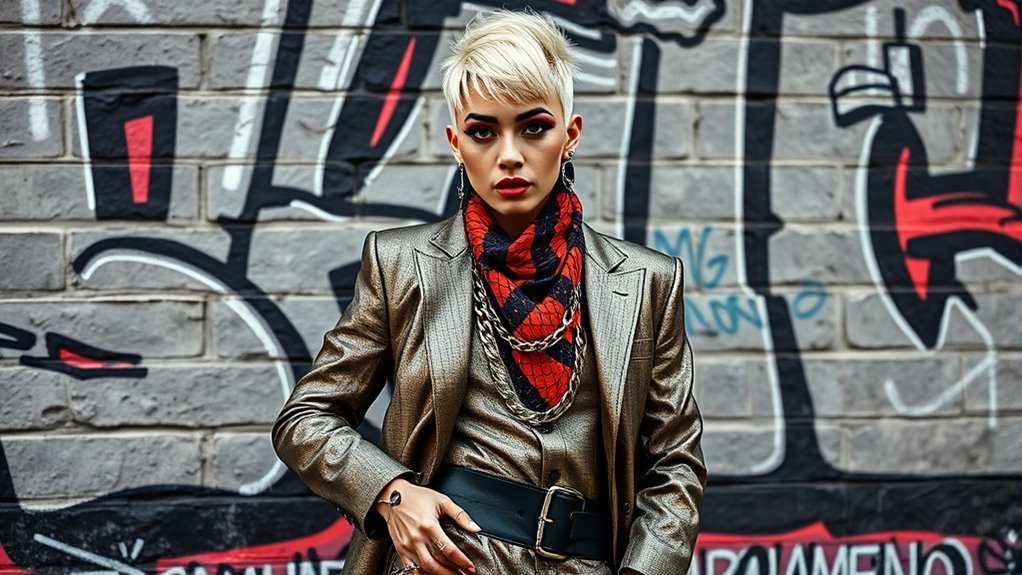
Throughout fashion history, bold individuals have challenged traditional styles, pushing the boundaries of gender expression. You might look to icons like Marlene Dietrich, who defied gender norms with tailored suits and dramatic flair, or David Bowie, whose androgynous looks blurred lines between male and female fashion. You could also consider designers like Jean-Paul Gaultier, who incorporated gender-fluid designs into mainstream collections, inspiring others to rethink clothing boundaries. These pioneers used their visibility and creativity to challenge societal expectations, encouraging others to experiment beyond conventional gender categories. Their influence paved the way for more inclusive fashion, empowering everyone to express themselves freely. By breaking norms, these trailblazers transformed fashion into a space of personal liberation and limitless possibilities.
The Rise of Gender-Neutral Clothing Lines

You’ll notice that gender-neutral clothing lines are expanding market diversity by appealing to a wider range of customers. These styles challenge traditional norms, encouraging more freedom of expression for everyone. As this trend grows, it prompts a reevaluation of what clothing truly represents in today’s society. Incorporating inclusive fashion techniques into fashion campaigns can also enhance emotional appeal and brand storytelling. Recognizing halal standards in fabric and production processes can further promote ethical and inclusive designs. Additionally, understanding regional resources and tools available for designers can facilitate the development of such innovative collections. Furthermore, acknowledging the importance of emotional support can help brands connect more deeply with diverse audiences and foster a sense of community around inclusive fashion initiatives.
Expanding Market Diversity
As societal attitudes toward gender continue to evolve, more fashion brands are introducing gender-neutral clothing lines to meet the growing demand for inclusive options. This shift expands market diversity by appealing to a broader audience that seeks clothing beyond traditional gender categories. You’ll notice brands offering versatile pieces that suit different styles, body types, and preferences, making fashion more accessible. This inclusivity attracts consumers who previously felt excluded or underserved by conventional collections. As a result, sales increase, and brands stand out by embracing diversity. The move toward gender-neutral fashion also encourages other companies to rethink their offerings, fostering a more dynamic and inclusive industry. Ultimately, this trend reflects a cultural push toward recognizing individual identity and breaking down outdated stereotypes. Additionally, understanding market diversity helps brands better cater to evolving consumer preferences and enhances their competitive edge in a rapidly changing industry. Recognizing the importance of industry trends ensures that brands stay relevant and innovative in a competitive landscape.
Challenging Traditional Norms
The rise of gender-neutral clothing lines marks a bold challenge to long-standing fashion norms rooted in binary gender distinctions. It encourages you to see clothing as a form of self-expression, not confined by traditional labels. These lines blur the lines between male and female styles, promoting inclusivity and freedom. By choosing gender-neutral options, you’re supporting a shift toward diversity and acceptance. To illustrate, consider the following:
| Traditional Norms | New Perspectives |
|---|---|
| Men wear suits | Unisex oversized blazers |
| Women wear dresses | Gender-neutral jumpsuits |
| Bright colors for women | Muted tones for all genders |
| Strictly masculine | Soft, fluid designs |
| Gender-specific sizes | One-size-fits-all options |
This movement is redefining what fashion can be, making it more accessible and authentic for everyone. Additionally, many brands are incorporating inclusive sizing to ensure fashion is truly for all body types. Recognizing the importance of diversity in fashion, designers are increasingly embracing a broader spectrum of styles and sizes to cater to everyone’s unique preferences and identities.
Runway Revelations: Celebrating Diversity and Inclusion

Have fashion runways truly embraced diversity and inclusion? Increasingly, they showcase models of different genders, sizes, ethnicities, and ages, breaking traditional standards. This shift reflects a genuine effort to represent everyone. You’ll notice designers highlighting:
- Runway shows featuring non-binary and gender-fluid models
- Celebrations of various body types, from slim to plus-size
- Inclusion of models from diverse cultural backgrounds
These initiatives challenge the old notion of a narrow beauty ideal and promote authenticity. You’re encouraged to see fashion as a platform that empowers individuals to express their identity freely. As more brands prioritize representation, runways become a mirror of society’s evolving understanding of beauty and gender. This movement signals progress towards a more inclusive and accepting fashion industry. Incorporating ethical hacking principles into marketing strategies can also help brands protect their digital assets and ensure authentic representation online. Additionally, recognizing the importance of butter in various cultural cuisines highlights how food and fashion often serve as expressions of identity and tradition. Understanding how Bitcoin IRA offers investment options can inspire designers to consider innovative approaches to brand growth and financial security, paralleling the way automotive upgrades serve individual needs. Furthermore, embracing diverse cultural influences can enrich the creative process and foster innovation within the industry.
How Social Media Shapes Modern Fashion Perspectives
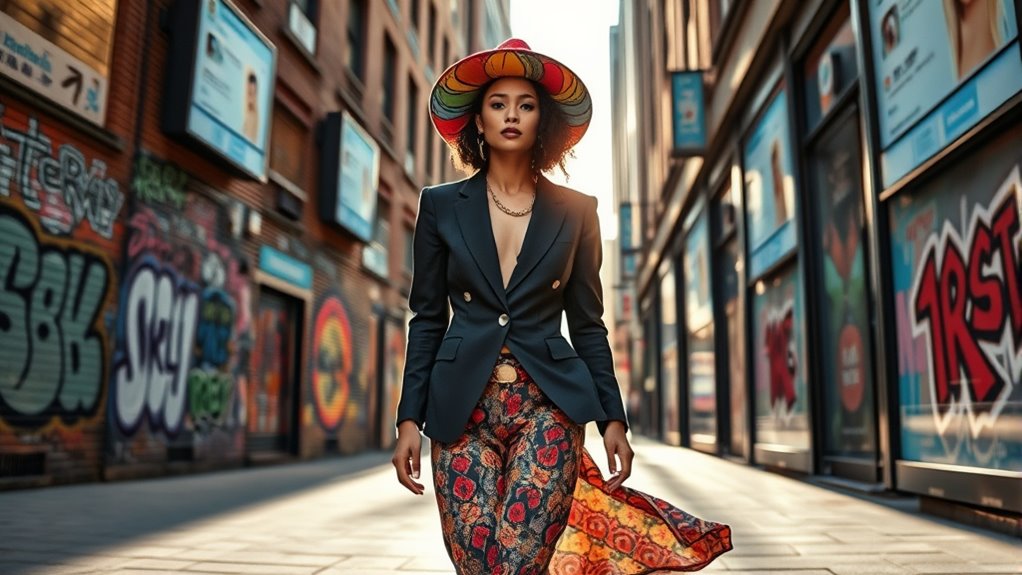
Social media has revolutionized how you discover and engage with fashion, making trends and styles more accessible than ever before. Through platforms like Instagram, TikTok, and Pinterest, you can instantly see what influencers, designers, and brands are showcasing worldwide. This immediacy allows you to stay updated on the latest styles and experiment with new looks without waiting for traditional media or store visits. Social media also empowers you to share your own fashion choices, fostering a sense of community and influence. Hashtags and algorithms tailor content to your preferences, shaping your perspective on what’s fashionable. As a result, your fashion sense becomes more diverse and personalized, breaking down barriers of geography, age, and gender. Ultimately, social media democratizes fashion, putting style power directly into your hands. Embracing this digital shift can also inspire you to explore creative expression and develop a personal style voice. Moreover, the rapid dissemination of fashion trends through social media has led to a more dynamic and inclusive fashion landscape, encouraging diverse representations and breaking traditional beauty standards. This phenomenon is closely linked to the evolution of sound design techniques, which also adapt rapidly to new forms of media and cultural shifts. Additionally, the integration of innovative technology in fashion showcases how digital tools are reshaping design and consumer experiences.
The Impact of Cultural Shifts on Style Choices
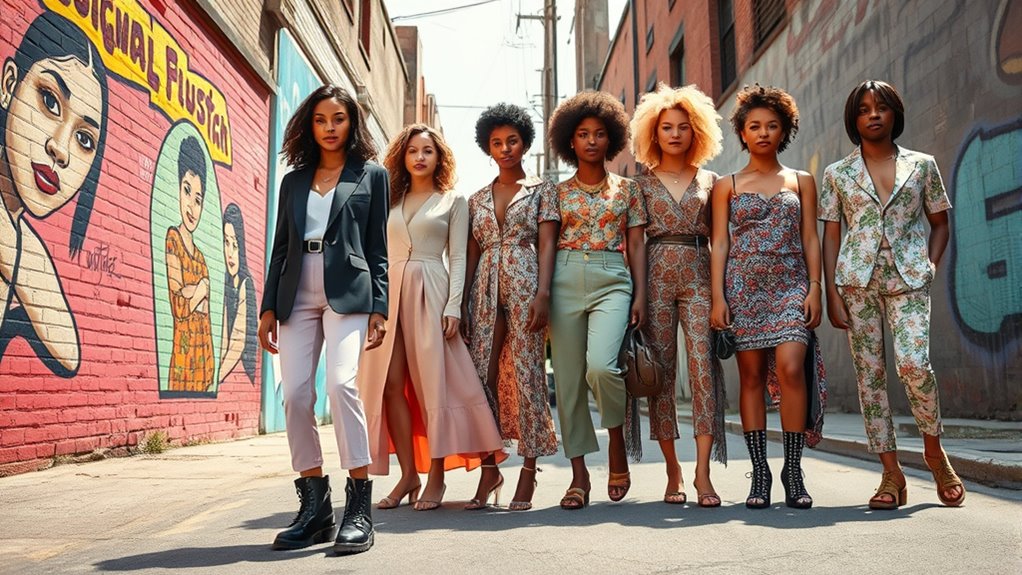
As societies evolve, shifting cultural values profoundly influence your style choices, reflecting new attitudes towards identity, equality, and expression. These changes open doors for more diverse and inclusive fashion options, encouraging you to experiment beyond traditional norms. You might notice how cultural movements promote gender-neutral clothing, challenge stereotypes, and celebrate individuality. Additionally, the cultural shifts are also influencing the fashion industry’s approach to sustainable and ethically-made clothing, aligning style with social values. These shifts empower you to explore new aesthetics, blend influences, and express yourself authentically. Furthermore, market positioning strategies are increasingly emphasizing inclusivity and social responsibility, shaping the apparel available to consumers today. Predictive modeling techniques are helping brands anticipate changing consumer preferences and adapt accordingly, ensuring your style remains current and relevant. The evolving societal understanding of identity allows for more personalized and authentic fashion choices, making your style more meaningful and inclusive. Additionally, fostering leadership skills within the industry promotes innovative approaches to designing and marketing inclusive fashion lines that resonate with diverse audiences.
Embracing Authenticity: Personal Style Beyond Labels

Moving beyond traditional labels allows you to craft a personal style rooted in genuine self-expression rather than societal expectations. Instead of conforming to predefined categories, focus on what feels authentic to you. Mix and match pieces that reflect your personality, regardless of gender norms or trends. Confidence comes from embracing your individuality and making deliberate choices that resonate with your identity. Don’t be afraid to experiment or defy conventions—authenticity shines through when you wear what makes you feel comfortable and true to yourself. Remember, style isn’t about fitting into a box; it’s about expressing who you are without apology. By prioritizing authenticity, you create a look that’s uniquely yours, empowering you to break free from limiting labels and celebrate your true self. Incorporating personal expression can further reinforce your confidence and help you develop a distinctive style that truly represents you, especially when understanding the importance of cultural intelligence for navigating diverse fashion influences and safety considerations for vetted products. Recognizing the importance of self-awareness can also enhance your ability to select styles that genuinely resonate with your identity and values.
Future Trends in Gender-Inclusive Fashion

Have you noticed how gender-inclusive fashion is rapidly evolving? Trends are shifting towards more fluid and versatile styles that challenge traditional boundaries. Designers are increasingly focusing on sustainable materials and innovative cuts that suit all genders. Expect to see more unisex collections blending elements from different styles, making fashion more accessible. Technology also plays a role, with virtual fitting rooms and customizable apparel becoming mainstream. Additionally, brands are embracing diversity, showcasing models of various genders, sizes, and backgrounds.
Gender-inclusive fashion is embracing versatility, sustainability, and diversity through innovative designs and digital technology.
Future trends include:
- Expanding gender-neutral clothing lines that emphasize comfort and self-expression
- Incorporating sustainable, eco-friendly fabrics into inclusive collections
- Using digital platforms to promote gender fluidity and broaden access to diverse styles
Frequently Asked Questions
How Do Gender Norms Influence Fashion Marketing Strategies?
You see how gender norms shape fashion marketing strategies by guiding brand messaging and product design. Marketers often target specific gender stereotypes, influencing color choices, styles, and advertising language to appeal to traditional expectations. By understanding these norms, you can spot how brands either reinforce or challenge societal ideas about gender, helping you make more conscious choices and recognize efforts to break boundaries in fashion marketing.
What Role Do Gender Stereotypes Play in Fashion Advertising?
Gender stereotypes in fashion advertising shape your perceptions, limit your choices, and reinforce outdated norms. They often depict men as strong and dominant, women as delicate and nurturing, and ignore diversity. You might find yourself influenced by these stereotypes, accepting narrow ideals of beauty and style. Breaking free from these molds empowers you to embrace authentic self-expression, challenge stereotypes, and demand inclusive, diverse fashion that reflects real life and your unique identity.
Can Gender-Neutral Fashion Be Sustainable and Affordable?
You might think gender-neutral fashion isn’t sustainable or affordable, but it can be both. By using eco-friendly fabrics and streamlined production methods, brands can reduce costs and environmental impact. When you support these brands, you’re encouraging a shift toward more inclusive, sustainable options that break traditional boundaries. So, yes, gender-neutral fashion can be accessible and eco-conscious, making style more inclusive without sacrificing affordability or sustainability.
How Do Age and Cultural Backgrounds Affect Gender Expression in Fashion?
Age and cultural backgrounds greatly influence your gender expression in fashion. Younger generations might experiment more freely, embracing trends that challenge norms, while older individuals may prefer classic styles that reflect their experiences. Cultural backgrounds shape your choices, guiding what you feel comfortable wearing and how you express yourself. You adapt fashion to honor your identity and heritage, blending influences to create a unique style that reflects who you are across different contexts.
What Challenges Do Lgbtq+ Designers Face in the Fashion Industry?
Imagine steering a runway where every step is scrutinized—that’s what LGBTQ+ designers often face. They encounter hurdles like industry bias, limited representation, and conservative standards that resist change. For instance, some struggle to get mainstream recognition or face rejection for challenging traditional gender norms. Despite these challenges, many push boundaries, transforming fashion into a more inclusive space, proving that true style knows no gender.
Conclusion
You’ve seen how gender and fashion are shattering every barrier, transforming the world into a runway of limitless self-expression. This isn’t just a trend—it’s a revolution that’ll rewrite history! As boundaries keep falling, you’ll step into a future where your style is as wild, bold, and unapologetic as you are. Get ready to turn heads and challenge norms—because the era of true fashion freedom is just beginning, and it’s more epic than you ever imagined!
